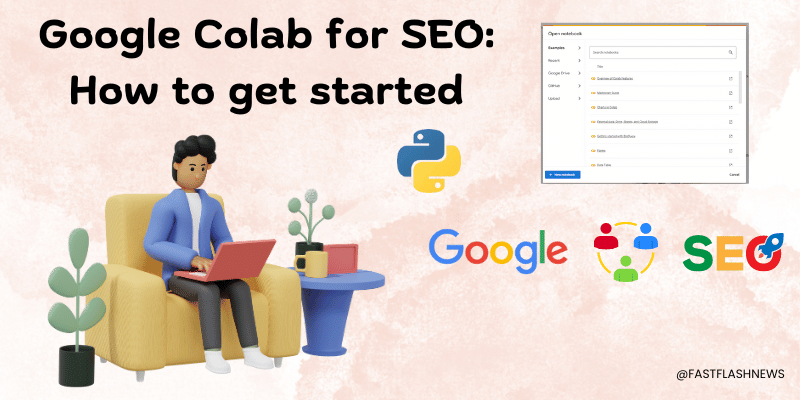Google Colab has been operating since 2017, however it has lately gained prominence as SEO specialists share code examples.
SEOs choose Colab because, unlike GitHub, you can execute code directly on the platform.
What is Google Colab?
- Google Colab is a service that enables users to immediately execute Python straight on the platform with no setup. Google Colab is a hosted Jupyter Notebook that uses Google’s cloud hosting capabilities.
- If you’re new to Python, a Jupyter Notebook is a free online tool for writing code, solving math problems, creating graphs, and displaying your work. It works like a digital notepad, allowing you to save all of your project components in one location and simply share them with others.
- What’s the nicest part about Google Colab? It is free.
- If you need additional computer power, there is a tiered pricing scheme. As of writing, I am paying $9.99 per month for the first premium tier. The next tier is $49.99 a month, and there is a bespoke enterprise version.
Benefits of Google Colab
- I’ve personally savored the advantages of Google Colab for several years and am delighted to offer what I’ve discovered to be its most significant benefits for SEOs.
- Quick to start
- If you’ve ever installed Python on a local workstation, you know how inconvenient it is to get Python set up. In addition, if you’re testing out new code, you’ll most likely need to install additional libraries in order for it to execute.
- The nicest feature of Google Colab is that it already includes the majority of common Python libraries. If something is missing, just run:
- pip install new-library
- The only difference here is that you must use the exclamation point before pip to install a new library.
- Doesn’t use your computer’s bandwidth
- I frequently use Python to compute huge datasets, which can take quite some time. I’ve run some code that takes hours to execute owing to the magnitude of the data.
- In SEO, we frequently perform crawls and other analytics in the background as we work. Have you ever ran a Screaming Frog crawl that completely slows down your computer, making it hard to perform other SEO tasks?
- With Google Colab, you can simultaneously execute compute-intensive code and concentrate on other SEO activities.
Hareable
Google Colab is designed to be readily shared with partners or the whole globe. As a believer in the power of open source, I feel Google Colab is an excellent platform for me to share code with the SEO community.
AI integration
- Google has incorporated Gemini right into Google Colab. So, if you’re having trouble adding a new feature to your code, AI can help.
- I would advise care while doing this, since you may find yourself troubleshooting rather than helping yourself.
How to use Google Colab
- Let’s go right into how to utilize Google Colab. I’ll walk you through the eight most crucial aspects so you can get right to developing for SEO.
- How to Run Code
- The most fundamental step is to learn how to run the code.
- When you are ready to execute your code, click the play button.
How to open the folder pane
To run code that relies on source data or exports results to a file, you must first be allowed to open the directory. Fortunately, like running code, this is only one button, namely the one that resembles a folder.
How to connect to Google Drive
- One of the best things about Google Colab is that it is part of the Google suite of tools, so you can link directly to files in Google Drive and even store your results there.
- To connect to Google Drive, first mount it using the button indicated in the screenshot below.Once Colab has completed mounting Google Drive, your Google Drive folder will show in the files pane.
- From here, you may reference any of those files by right-clicking on them, selecting a copy path, and copying it anywhere you need to use them in your code.
How to upload files manually
- Before you submit any files, keep in mind that they will not be preserved and will only be used temporarily. When you refresh or close the website, the files will disappear.
- If you want the files to remain accessible, you must utilize Google Drive and link to them that way (see preceding procedures).
- If you are okay with utilizing files temporarily, you have two possibilities. You may drag and drop files from your computer into the files pane or use the upload button.
How to generate new files directly in Google Colab
- Sometimes I like to generate new files straight in Google Colab.
- For example, if I have a list of keywords that I want to analyze, it is quicker for me to copy and paste them into a file on Colab rather than creating a new file on my computer and uploading it.
- To accomplish this, just right-click a blank area in the files window and select New File. From there, you may give it any name you want, paste your data, and save it using your hotkeys.
How to download results
- After running the code, you may be left with an exported file.
- You may preview the file by double-clicking on it, but to download it, simply right-click on it and select Download.
How to connect to a runtime
- If you’re running code that may require a higher computational burden, you might wish to try with a quicker runtime.
- To achieve this, go to the top menu and click Runtime, followed by Change runtime type from the selection.
- From there, you’ll notice various possibilities to adjust.
- Please keep in mind that changing the runtime will result in the removal of any files from the file pane.
How To Use the AI Integration
- Gemini integration is one of the most recent features added to Google Colab. Google has made it simple to use this new function by adding a Gemini button to the top right of the screen.
- By hitting that, a sidebar will open allowing you to ask it questions.
Free code to get you started
- Now that you’ve completed the crash course on getting started with Google Colab, it’s time to attempt some code!
- at one of my earlier blogs, I shared five Python scripts for SEO that you can test right now at Google Colab.
- In that article, you will see the context of the scripts, how to set them up, and I will share the real code for you to try.
- It’s never been easier to get started with Python for SEO.




